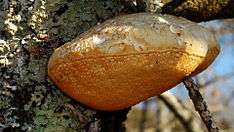Spongipellis
Spongipellis is a genus of fungi in the family Polyporaceae. The genus is widely distributed[1] and contains ten species.[2] The genus was circumscribed by French mycologist Narcisse Théophile Patouillard in 1887.[3] The genus name combines the Latin words spongia ("sponge") and pellis ("skin").[4]
| Spongipellis | |
|---|---|
 | |
| Spongipellis unicolor | |
| Scientific classification | |
| Kingdom: | |
| Division: | |
| Class: | |
| Order: | |
| Family: | |
| Genus: | Spongipellis Pat. (1874) |
| Type species | |
| Spongipellis spumeus (Sowerby) Pat. (1887) | |
Species
As of June 2017, Index Fungorum accepts ten species of Spongipellis:[2]
- S. africana Ipulet & Ryvarden (2005) – Uganda[5]
- S. caseosus (Pat.) Ryvarden (1983)
- S. chubutensis J.E.Wright & J.R.Deschamps (1972)[6]
- S. delectans (Peck) Murrill (1907)
- S. hypococcineus (Berk.) Pat. (1900)
- S. labyrinthicus (Fr.) Pat. (1900)
- S. litschaueri Lohwag (1931) – Czech Republic
- S. malicola (Lloyd) Ginns (1984)
- S. subcretaceus (Lloyd) Decock, P.K.Buchanan & Ryvarden (2000)
- S. unicolor (Fr.) Murrill (1907)
- S. pachyodon
Further reading
- Tomšovský, Michal (2012). "Delimitation of an almost forgotten species Spongipellis litschaueri (Polyporales, Basidiomycota) and its taxonomic position within the genus". Mycological Progress. 11 (2): 415–424. doi:10.1007/s11557-011-0756-z.
gollark: Hey, those are Macron instructions!
gollark: Ah yes, PHP.
gollark: Just use a general algebra doer™ and simplify it to 1.
gollark: That would have been mean and thus impossible.
gollark: No.
References
- Kirk, P.M.; Cannon, P.F.; Minter, D.W.; Stalpers, J.A. (2008). Dictionary of the Fungi (10th ed.). Wallingford, UK: CAB International. p. 652. ISBN 978-0-85199-826-8.
- Kirk, PM. "Species Fungorum (version 29th May 2017). In: Species 2000 & ITIS Catalogue of Life". Retrieved 2017-06-21.
- Patouillard N. (1887). Les Hyménomycètes d'Europe (in French). p. 140.
- Donk, M.A. (1960). "The generic names proposed for Polyporaceae". Persoonia. 1 (2): 173–302.
- Ipulet, P.; Ryvarden, L. (2005). "New and interesting polypores from Uganda". Synopsis Fungorum. 20: 87–99.
- Wright, J.E.; Deschamps, J.R. (1972). "Basidiomycetes xilófagos de los bosques andinopatagónicos". Revista Trimestral de Investigaciones Agropecuarias de la Region Centro Occidental (in Spanish). 9 (3): 111–204.
This article is issued from Wikipedia. The text is licensed under Creative Commons - Attribution - Sharealike. Additional terms may apply for the media files.